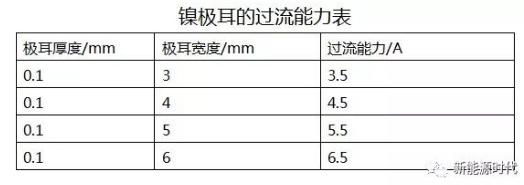- English
- Español
- Português
- русский
- Français
- 日本語
- Deutsch
- tiếng Việt
- Italiano
- Nederlands
- ภาษาไทย
- Polski
- 한국어
- Svenska
- magyar
- Malay
- বাংলা ভাষার
- Dansk
- Suomi
- हिन्दी
- Pilipino
- Türkçe
- Gaeilge
- العربية
- Indonesia
- Norsk
- تمل
- český
- ελληνικά
- український
- Javanese
- فارسی
- தமிழ்
- తెలుగు
- नेपाली
- Burmese
- български
- ລາວ
- Latine
- Қазақша
- Euskal
- Azərbaycan
- Slovenský jazyk
- Македонски
- Lietuvos
- Eesti Keel
- Română
- Slovenski
- मराठी
- Srpski језик
Calculation of the Design Formula for Lithium Battery Ears!
2023-06-06
Calculation of the Design Formula for Lithium Battery Ears!
The positive and negative terminals of a typical lithium battery are connected to the negative and positive caps through internal nickel or aluminum lugs, respectively. Of course, the design of the pole ear has a significant impact on the over current capacity. Below is an introduction to the pole ear design theory
1、 Theoretical parameters of polar ear material
(1) The safe current carrying value of the nickel electrode ear is 11-13A/mm2, the conductivity of nickel is 140000 S/cm, and the melting point is between 1200 ℃ and 1400 ℃.

(2) The safe current carrying value of the copper electrode ear is 5-8A/mm2, the conductivity of copper is 584000 S/cm, and the melting point is ≈ 1000 ℃.
(3) The safe current carrying value of the aluminum electrode ear is 3-5A/mm2, the conductivity of nickel is 369000 S/cm, and the melting point is ≈ 660 ℃.
2、 Theoretical Design of the Influence of the Geometric Position of the Polar Ear on Impedance
The farther the current collector (foil) is away from the electrode ear, the weaker the overcurrent; The average current value is half of the collector impedance, and in simple terms, the effective impedance Reff is half of the collector impedance Ro
Reff=Rc/2 or Ra/2

among
① Rc is the impedance value of the positive set fluid
② Ra is the negative fluid impedance value
(1) The pole ear is located in the middle of the pole piece

E=(I/2)2*(Ro/4)+(I/2)2*(Ro/4)= I2*(1/8)Ro= I2*Reff
(2) The pole ear is located at 1/3 of the pole piece

E=(I/3)2*(Ro/6)+(2I/3)2*(2Ro/6)= I2*(1/6)Ro
(3) Unipolar ear in any position

E=I2*[x2*x/2+(1-x)2*(1-x)/2]Ro
(4) Bipolar ear in any position




